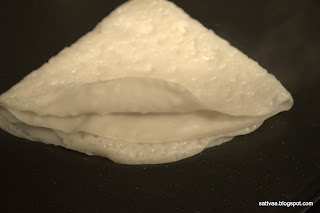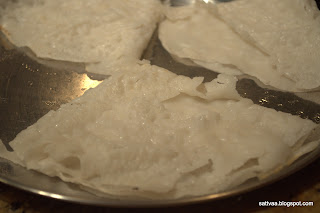It is raining outside for the last 2 days and I am telling myself to stay away from my standard abode of deep fried snacks in this tempting weather but the cravings are just getting worse with every falling raindrop :-). Thoda Khatta, Thoda meetha, Thoda thika is what I want and the recipe below is a perfect blend of all these tastes and more. Oh yes I didn't need to put a pan full of oil and fry something either. This is a hands down win-win situation.
For people from Karnataka, Pathrode is either a Malenadu/Malnad or Mangalore delicacy, there are various ways of making this delicious recipe as the masala may change its shape & form from family to family. There are other versions of Pathrode elsewhere in India - such as the Patra from Maharastra or Gujarat. While the pathrode made with colocasia leaves still holds the top slot in popularity, the easier to make cabbage pathrode gives a tough competition.
A Mangalorean aunty who lived next door made these cabbage pathrode which were a new taste and treat for us Mysore people. I was a tiny tot who only remembers the taste even to this day but was not a kitchen enthusiast to ask for the recipe from aunty :-). I think amma had this recipe memorized at some point but somehow this dish kind of dropped out of the radar as the aunty moved to a different city and we lost touch with their family. There is a (or was a) Woodies restuarant on Commercial street in Bengaluru that had cabbage pathrode on their menu but as I remember it was on a week day only and I never got to try it.
Then when I started working, I had a friend A from Mangalore whose mom cooked delicious food but A could care less as she was totally oblivious to the joys of cooking. I had to pester her for this recipe for almost 3 years before she sent me an email with 'Hey N, here you go, I finally remembered to ask my mom about the cabbage pathrode recipe, you need coriander seeds, red chilies, little bit fenugreek, and a little bit jira... and etc' :-). It was hilarious and I still store a print out of that email safely tucked away in my cook books. But that gave me a decent start and I went on to play with the ingredients list and get the proportions to tickle my family's taste buds the right way. So here is a tried and tested cabbage pathrode recipe.
Cabbage pathrode is sweet, tangy, fiery chili spicy all at the same time along with coriander and cumin lending their unmistakable flavor. Play around with the red chilies or tamarind or jaggery quantity to enjoy it the way you like most.
What do you need to make Cabbage Pathrode?
Makes about 20-2x2x1 inch pieces
2 cups finely chopped cabbage
1.5 cups idli rava
2 Tblsp oil (divided use)
To roast & grind:
3 Tblsp urad dal
1/2 Tsp fenugreek seeds
1/2 Tsp cumin seeds
6-8 dry red chilies (adjust to taste)
To grind:
1X1 inch piece tamarind/1 Tsp tamarind concentrate
1 Tblsp coriander seeds
1 Tblsp crushed jaggery/brown sugar
2 Tblsp chopped onion
3 Tblsp grated coconut (fresh or frozen)
1.5 Tblsp salt (adjust to taste)
How do you make Cabbage Pathrode?
For people from Karnataka, Pathrode is either a Malenadu/Malnad or Mangalore delicacy, there are various ways of making this delicious recipe as the masala may change its shape & form from family to family. There are other versions of Pathrode elsewhere in India - such as the Patra from Maharastra or Gujarat. While the pathrode made with colocasia leaves still holds the top slot in popularity, the easier to make cabbage pathrode gives a tough competition.
A Mangalorean aunty who lived next door made these cabbage pathrode which were a new taste and treat for us Mysore people. I was a tiny tot who only remembers the taste even to this day but was not a kitchen enthusiast to ask for the recipe from aunty :-). I think amma had this recipe memorized at some point but somehow this dish kind of dropped out of the radar as the aunty moved to a different city and we lost touch with their family. There is a (or was a) Woodies restuarant on Commercial street in Bengaluru that had cabbage pathrode on their menu but as I remember it was on a week day only and I never got to try it.
Then when I started working, I had a friend A from Mangalore whose mom cooked delicious food but A could care less as she was totally oblivious to the joys of cooking. I had to pester her for this recipe for almost 3 years before she sent me an email with 'Hey N, here you go, I finally remembered to ask my mom about the cabbage pathrode recipe, you need coriander seeds, red chilies, little bit fenugreek, and a little bit jira... and etc' :-). It was hilarious and I still store a print out of that email safely tucked away in my cook books. But that gave me a decent start and I went on to play with the ingredients list and get the proportions to tickle my family's taste buds the right way. So here is a tried and tested cabbage pathrode recipe.
Cabbage pathrode is sweet, tangy, fiery chili spicy all at the same time along with coriander and cumin lending their unmistakable flavor. Play around with the red chilies or tamarind or jaggery quantity to enjoy it the way you like most.
What do you need to make Cabbage Pathrode?
Makes about 20-2x2x1 inch pieces
2 cups finely chopped cabbage
1.5 cups idli rava
2 Tblsp oil (divided use)
To roast & grind:
3 Tblsp urad dal
1/2 Tsp fenugreek seeds
1/2 Tsp cumin seeds
6-8 dry red chilies (adjust to taste)
To grind:
1X1 inch piece tamarind/1 Tsp tamarind concentrate
1 Tblsp coriander seeds
1 Tblsp crushed jaggery/brown sugar
2 Tblsp chopped onion
3 Tblsp grated coconut (fresh or frozen)
1.5 Tblsp salt (adjust to taste)
How do you make Cabbage Pathrode?
- Heat 1 Tblsp oil, add urad dal, cumin, fenugreek seeds and red chilies and roast them on medium heat until urad dal turns bright pink (2-3 minutes)
- Grind all items listed above along with the roasted ingredients from the step above into a coarse chutney, add about 1/2 cup water as needed.
- In a mixing bowl, mix together idli rava, chopped cabbage and the ground masala paste until it incorporates uniformly.
- The consistency of the mixed batter should be like the akki rotti batter, should hold shape when rolled into a ball without crumbling but should not be watery.
- Here are two ways to make the cabbage pathrode, you can make small lemon sized balls and steam them or your can pat the batter into a steamer vessel to about an inch thickness and steam them.
- I prefer steaming them as one flat slab as it is easier to cut into pieces and roast later on.
- Steam (like idli) for about 20 minutes, switch off and enjoy with coconut chutney or ketchup as a side to your evening cuppa.
3 ways to enjoy Cabbage Pathrode:
Right off the steamer:
- Enjoy the steamed pathrode without any embellishments
Roasted pathrode pieces:
- When the steamed pathrode cools down, cut them into desired shapes
- Heat a flat griddle, arrange the slices on top, drizzle a few drops of oil and roast them on medium heat until the surface turns light brown and crisp.
- Enjoy it as a snack with a dollop of ketchup or chutney.
Seasoned Pathrode:
- Break the steamed pathrode into crumbs.
- Make a seasoning with a Tblsp of oil, pinch of asafoetida, 1 Tsp mustard, a few curry leaves and optional dry red chili pieces.
- Add the pathode pieces into the seasoning pan, mix it and let cook for 3-4 minutes.
- Enjoy a bowl of the seasoned pathrode, use it as a side dish.
Notes:
- Do not add too much water to the batter - it dilutes the taste and doesn't steam to perfection.
- Steaming the pathrode is the same as making idlis - use your regular cooker and cooker vessels or idli cooker and idli plates.
- Taste the masala after you grind it - it should be tad bit high on all tastes as it will mellow down upon mixing it with the idli rava.
- You can use the ground masala as a perfect accompaniment to dosa or idli if you like spicy chutneys.
- Coriander seeds are not roasted in this recipe.
- It is important to roast the ingredients on medium heat and make sure urad dal gets cooked well, else you get that uncanny, unpleasant raw urad dal taste in the pathrode.





































![[Blog%2520Hop%255B2%255D.jpg]](http://lh5.ggpht.com/-aQtWgHRoNE4/UHQrta3HFTI/AAAAAAAAIjI/Ro3G3LpaiPo/s200/Blog%252520Hop%25255B2%25255D.jpg)









